Bacteria Filtration Efficiency for Different Types of Protective Face Masks
Abstract
:1. Introduction
2. Materials and Methods
2.1. Air Sampling Locations
2.2. Air Sampling Procedure
2.3. Face Masks
2.4. Agar Plate Preparation and Bacterial Determination
2.5. Data Analysis
3. Results and Discussion
4. Conclusions
Author Contributions
Funding
Institutional Review Board Statement
Informed Consent Statement
Data Availability Statement
Acknowledgments
Conflicts of Interest
References
- Konda, A.; Prakash, A.; Moss, G.A.; Schmoldt, M.; Grant, G.D.; Guha, S. Aerosol Filtration Efficiency of Common Fabrics Used in Respiratory Cloth Masks. ACS Nano 2020, 14, 6339–6347. [Google Scholar] [CrossRef] [PubMed]
- World Health Organization. Advice on the Use of Masks in the Context of COVID-19: Interim Guidance. 6 April 2020. Available online: https://apps.who.int/iris/handle/10665/331693 (accessed on 10 May 2022).
- Allen, J.G.; Ibrahim, A.M. Indoor air changes and potential implications for SARS-CoV-2 transmission. JAMA 2021, 325, 2112–2113. [Google Scholar] [CrossRef] [PubMed]
- Persily, A. Challenges in developing ventilation and indoor air quality standards: The story of ASHRAE Standard 62. Build. Environ. 2015, 91, 61–69. [Google Scholar] [CrossRef] [PubMed]
- European Centre for Disease Control. 2019 (COVID-19) in the EU/EEA. Coronavirus Disease. Available online: https://www.cdc.gov/coronavirus/2019-ncov/prevent-getting-sick/about-face-coverings.html (accessed on 11 March 2022).
- CSN EN 14683+AC-2019; Medical Facemasks—Requirements and Test Methods. European Committee for Standardization: Brussels, Belgium. Available online: https://www.en-standard.eu/csn-en-14683-ac-medical-face-masks-requirements-and-test-methods/ (accessed on 11 March 2022).
- BS EN 149:2001+A1; 2009 Respiratory Protective Devices. Filtering Half Masks to Protect against Particles. Requirements, Testing, Marking. European Committee for Standardization: Brussels, Belgium. Available online: https://standards.iteh.ai/catalog/standards/cen/f440f60a-91c1-497b-815e-4e9d46436256/en-149-2001a1-2009 (accessed on 11 March 2022).
- Li, Y.; Leung, P.; Yao, L.; Song, Q.W.; Newton, E. Antimicrobial effect of surgical masks coated with nanoparticles. J. Hosp. Infect. 2006, 62, 58–63. [Google Scholar] [CrossRef]
- Bayersdorfer, J.; Giboney, S.; Martin, R.; Moore, A.; Bartles, R. Novel manufacturing of simple masks in response to international shortages: Bacterial and particulate filtration efficiency testing. Am. J. Infect. Control. 2020, 48, 1543–1545. [Google Scholar] [CrossRef] [PubMed]
- Tcharkhtchi, A.; Abbasnezhad, N.; Zarbini, S.M.; Zirak, N.; Farzaneh, S.; Shirinbayan, M. An overview of filtration efficiency through the masks: Mechanisms of the aerosols penetration. Bioact. Mater. 2021, 6, 106–122. [Google Scholar] [CrossRef]
- Jung, H.; Kim, J.K.; Lee, S.; Lee, J.; Kim, J.; Tsai, P.; Yoon, C. Comparison of filtration efficiency and pressure drop in anti-yellow sand masks, quarantine masks, medical masks, general masks, and handkerchiefs. Aerosol Air Qual. Res. 2014, 14, 991–1002. [Google Scholar] [CrossRef]
- Davies, A.; Thompson, K.A.; Giri, K.; Kafatos, G.; Walker, J.; Bennett, A. Testing the efficacy of homemade masks: Would. they protect in an influenza pandemic? Disaster Med. Public Health Prep. 2013, 7, 413–418. [Google Scholar] [CrossRef]
- Whiley, H.; Keerthirathne, T.P.; Nisar, M.A.; White, M.A.F.; Ross, K.E. Viral filtration efficiency of fabric masks compared with surgical and N95 masks. Pathogens 2020, 9, 762. [Google Scholar] [CrossRef]
- Eikenberry, S.E.; Mancuso, M.; Iboi, E.; Phan, T.; Eikenberry, K.; Kuang, Y.; Kostelich, E.; Gumel, A.B. To mask or not to mask: Modelling the potential for face mask use by the general public to curtail the COVID-19 pandemic. Infect. Dis. Model. 2020, 5, 293–308. [Google Scholar] [CrossRef]
- Rengasamy, S.; Eimer, B.C. Nanoparticle penetration through filter media and leakage through face seal interface of N95 filtering face piece respirators. Ann. Occup. Hyg. 2012, 56, 568–580. [Google Scholar] [CrossRef]
- Rengasamy, S.; Eimer, B.; Shaffer, R.E. Simple Respiratory Protection–Evaluation of the Filtration Performance of Cloth Masks and Common Fabric Materials Against 20–1000 nm Size Particles. Ann. Occup. Hyg. 2010, 54, 789–798. [Google Scholar] [CrossRef]
- Shakya, K.M.; Noyes, A.; Kallin, R.; Peltier, R.E. Evaluating the efficacy of cloth facemasks in reducing particulate matter exposure. J. Expo. Sci. Environ. Epidemiol. 2017, 27, 352–357. [Google Scholar] [CrossRef]
- Borges, J.T.; Nakada, L.Y.K.; Maniero, M.G.; Guimarães, J.R. SARS-CoV-2: A systematic review of indoor air sampling for virus detection. Environ. Sci. Pollut. Res. 2021, 28, 40460–40473. [Google Scholar] [CrossRef] [PubMed]
- Feller, W. TTable of Statistical Corrections According to Feller for the BioCapt® Microbial Impactor in Microbial Air Sampling. Particle Measuring Systems 2018. 1950. Available online: https://www.pmeasuring.com/blog/table-of-statistical-corrections-according-to-fell/ (accessed on 9 May 2023).
- MacIntyre, C.R.; Seale, H.; Dung, T.C.; Hien, N.T.; Nga, P.T.; Chughtai, A.A.; Rahman, B.; Dwyer, D.E.; Wang, Q.; Cluster, A. Randomised trial of cloth masks compared with medical masks in healthcare workers. Open BMJ Publ. Group 2015, 5, e006577. [Google Scholar] [CrossRef] [PubMed]
- Yang, P.; Seale, H.; MacIntyre, C.R.; Zhang, H.; Zhang, Z.; Zhang, Y.; Wang, X.; Li, X.; Pang, X.; Wang, Q. Mask-wearing and respiratory infection in healthcare workers in Beijing, China. Braz. J. Infect. Dis. 2011, 15, 102–108. [Google Scholar] [CrossRef] [PubMed]
- Khan, H.A.A.; Karuppayil, S.M. Fungal pollution of indoor environments and its management. Saudi J. Biol. Sci. 2012, 19, 405–426. [Google Scholar] [CrossRef]
- Erbasan, F. Brain abscess caused by Micrococcus luteus in a patient with systemic lupus erythematosus: Case-based review. Rheumatol. Int. 2018, 38, 2323–2328. [Google Scholar] [CrossRef]
- Whyte, H.E.; Montigaud, Y.; Audoux, E.; Verhoeven, P.; Prier, A.; Leclerc, L.; Sarry, G.; Laurent, C.; Le Coq, L.; Joubert, A.; et al. Comparison of bacterial filtration efficiency vs. particle filtration efficiency to assess the performance of non-medical face masks. Sci. Rep. 2022, 12, 1188. [Google Scholar] [CrossRef] [PubMed]
- Asadi, S.; Cappa, C.D.; Barreda, S.; Wexler, A.S.; Bouvier, N.M.; Ristenpart, W.D. Efficacy of masks and face coverings in controlling outward aerosol particle emission from expiratory activities. Sci. Rep. 2020, 10, 15665. [Google Scholar] [CrossRef] [PubMed]
- Qian, Y.; Willeke, K.; Grinshpun, S.A.; Donnelly, J.; Coffey, C.C. Performance of N95 respirators: Filtration efficiency for airborne microbial and inert particles. Am. Ind. Hyg. Assoc. J. 1998, 59, 128–132. [Google Scholar] [CrossRef] [PubMed]
- Li, Y.; Wong, T.; Chung, J.; Guo, Y.P.; Hu, J.Y.; Guan, Y.T.; Yao, L.; Song, Q.W.; Newton, E. In vivo protective performance of N95 respirator and surgical facemask. Am. J. Ind. Med. 2006, 49, 1056–1065. [Google Scholar] [CrossRef] [PubMed]
- Bowen, L.E. Does that face mask really protect you? Appl. Biosaf. 2010, 15, 67–71. [Google Scholar] [CrossRef]
- Košir, T.; Fric, K.; Filipić, A.; Kogovšek, P. Bacterial Filtration Efficiency of Different Masks. Stroj. Vestn. J. Mech. E 2022, 68, 225–232. [Google Scholar] [CrossRef]
- Grinshpun, S.A.; Haruta, H.; Eninger, R.M.; Reponen, T.; McKay, R.T.; Lee, S.A. Performance of an N95 Filtering Facepiece Particulate Respirator and a Surgical Mask During Human Breathing: Two Pathways for Particle Penetration. J. Occup. Environ. Hyg. 2010, 6, 593–603. [Google Scholar] [CrossRef]
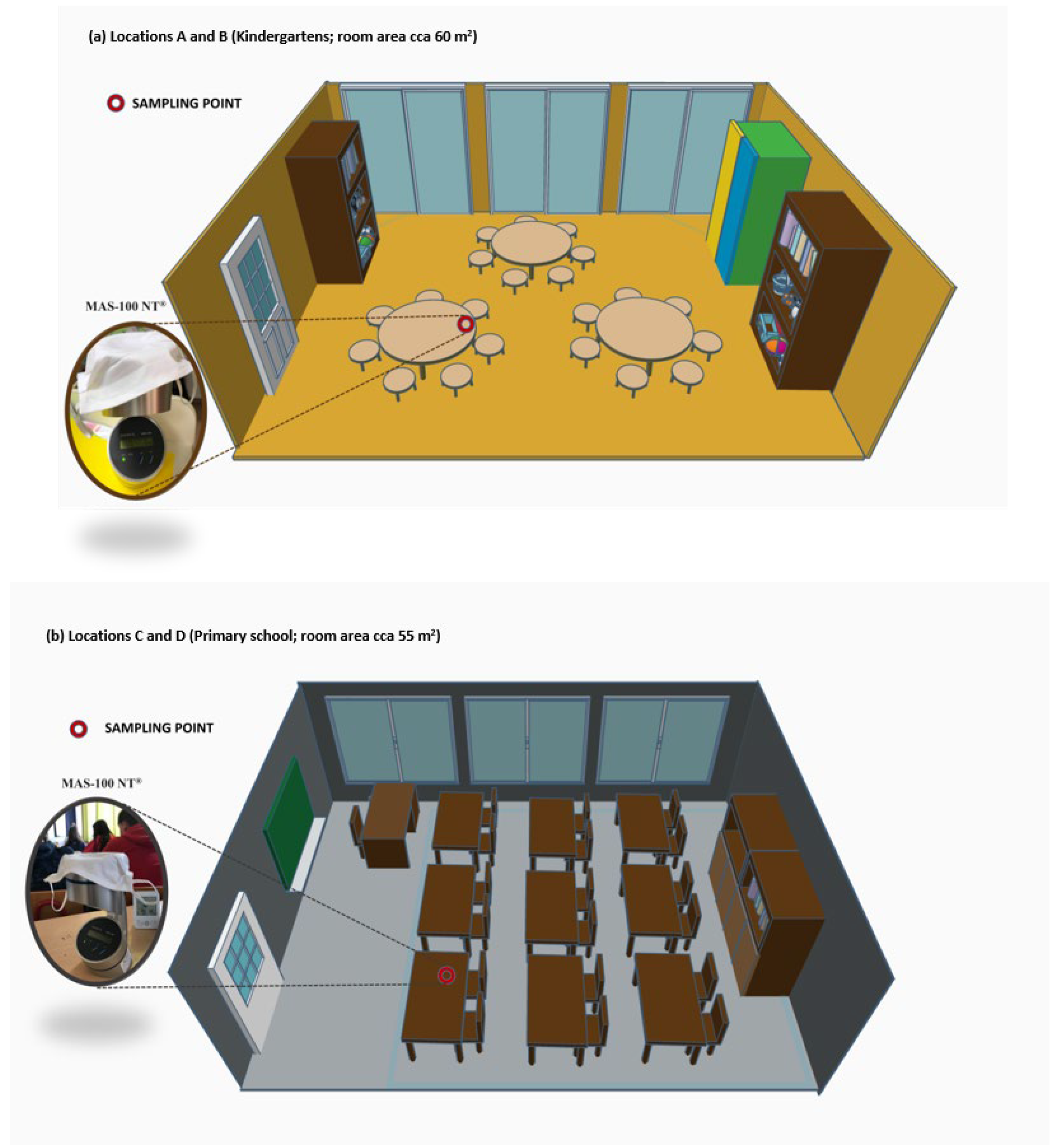
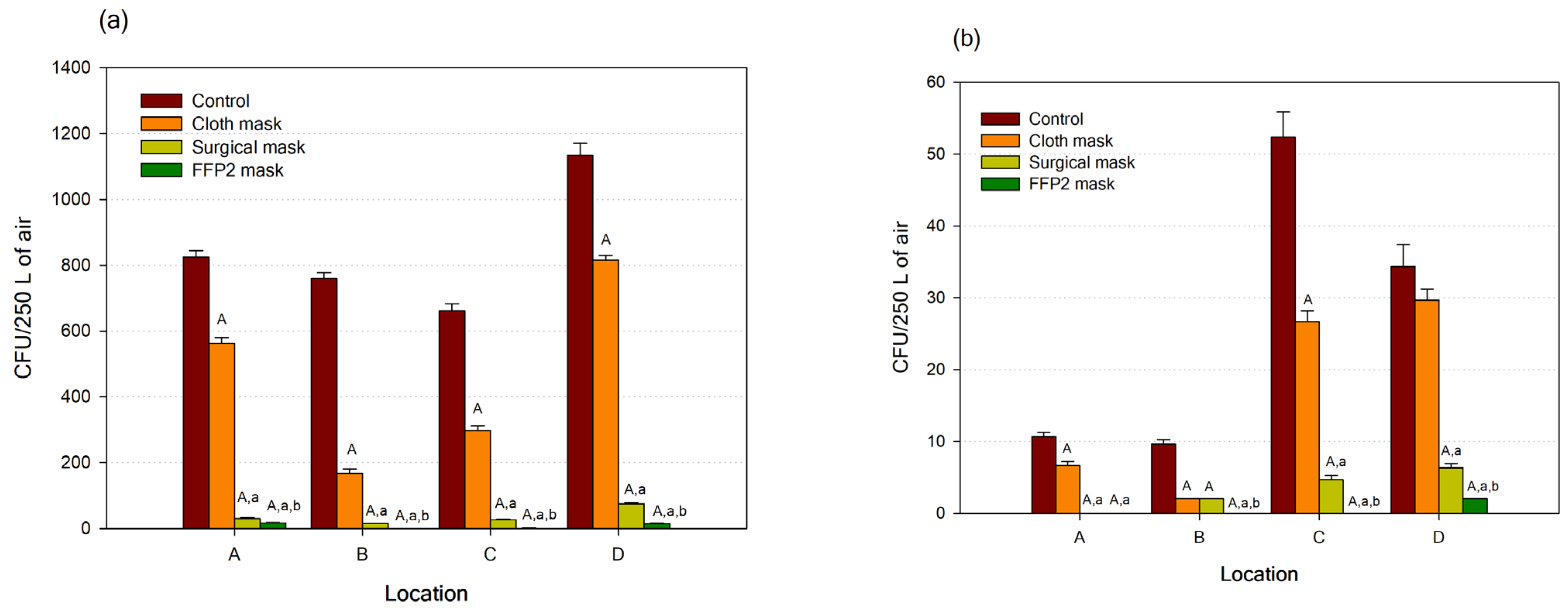
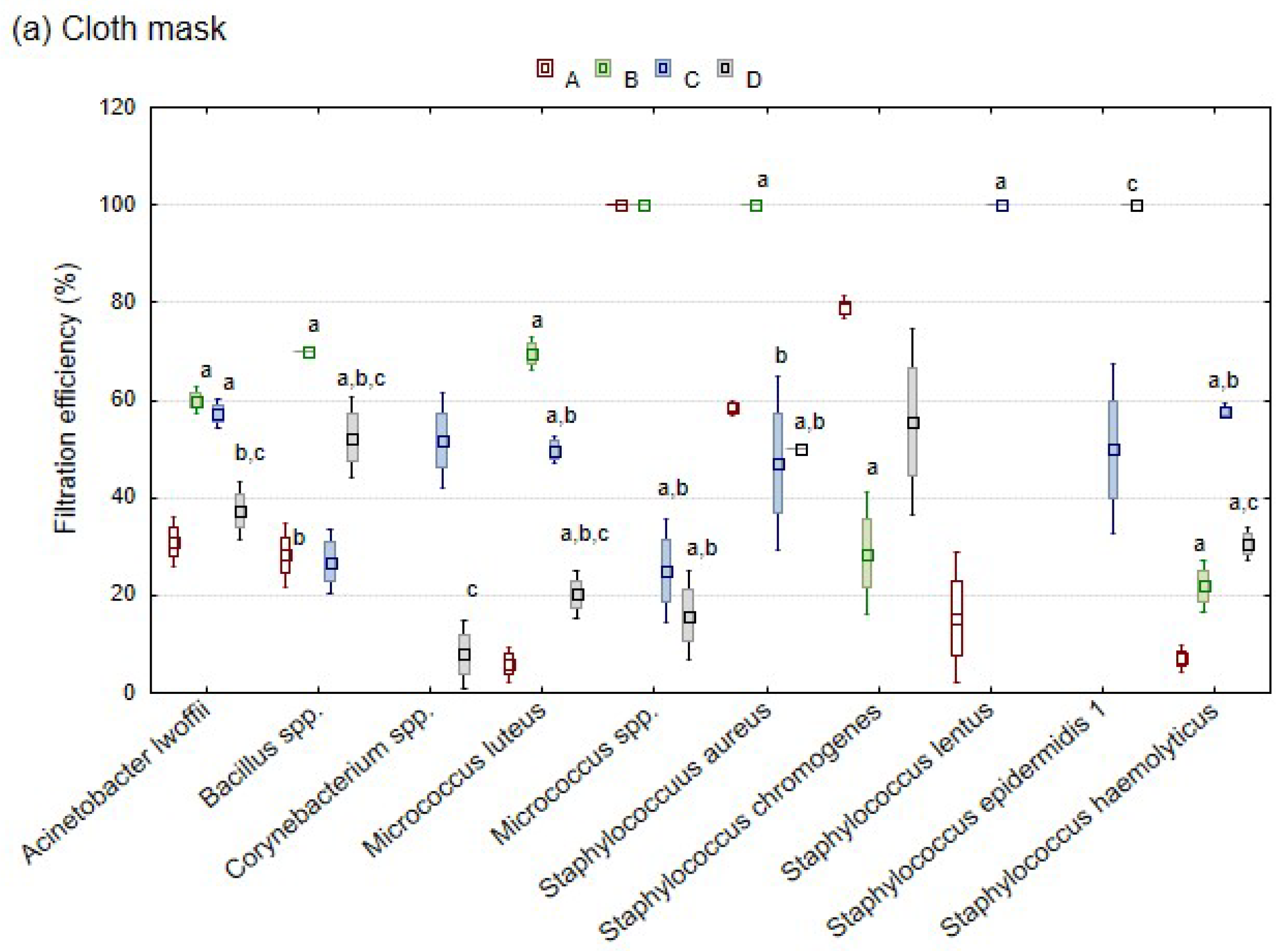
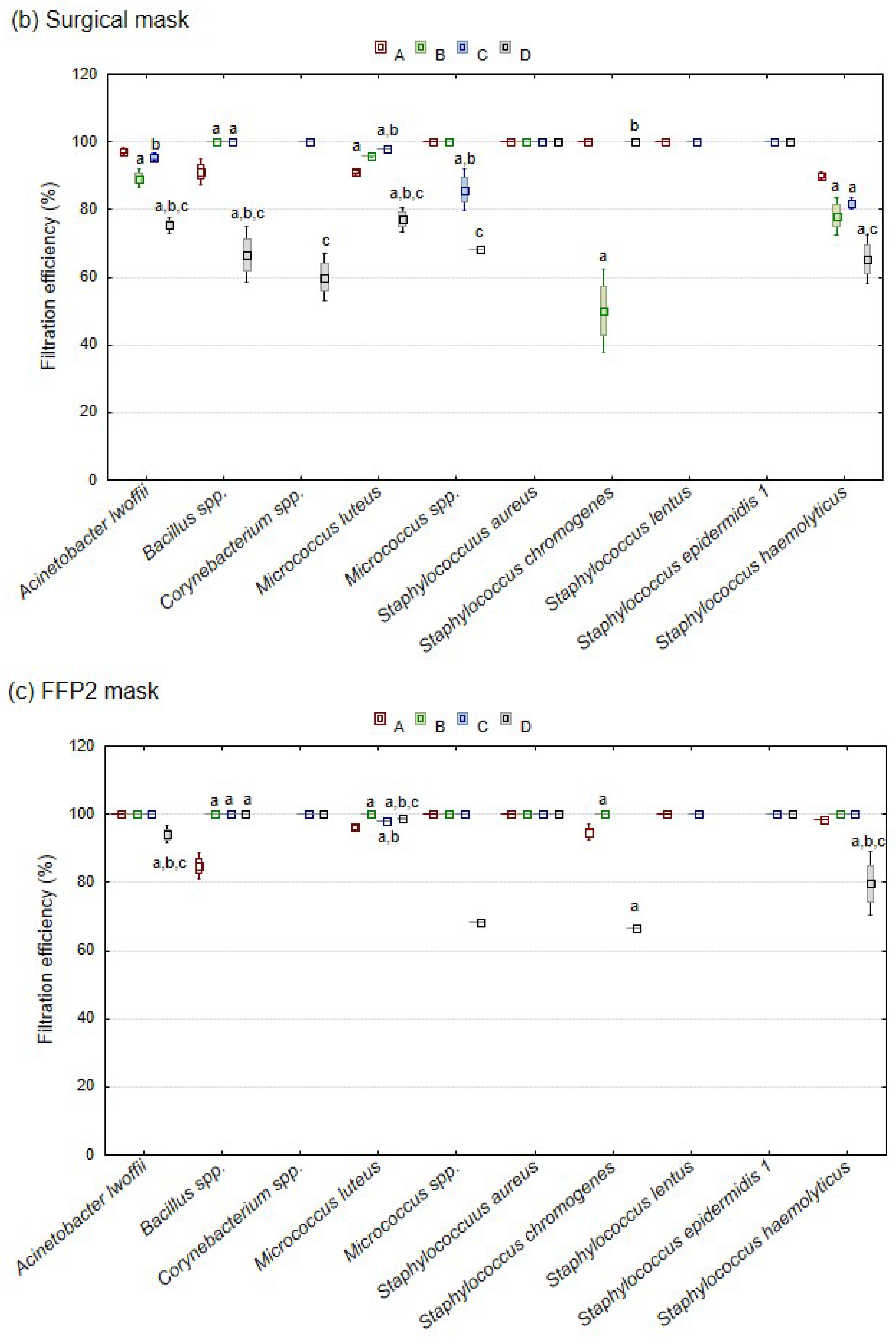
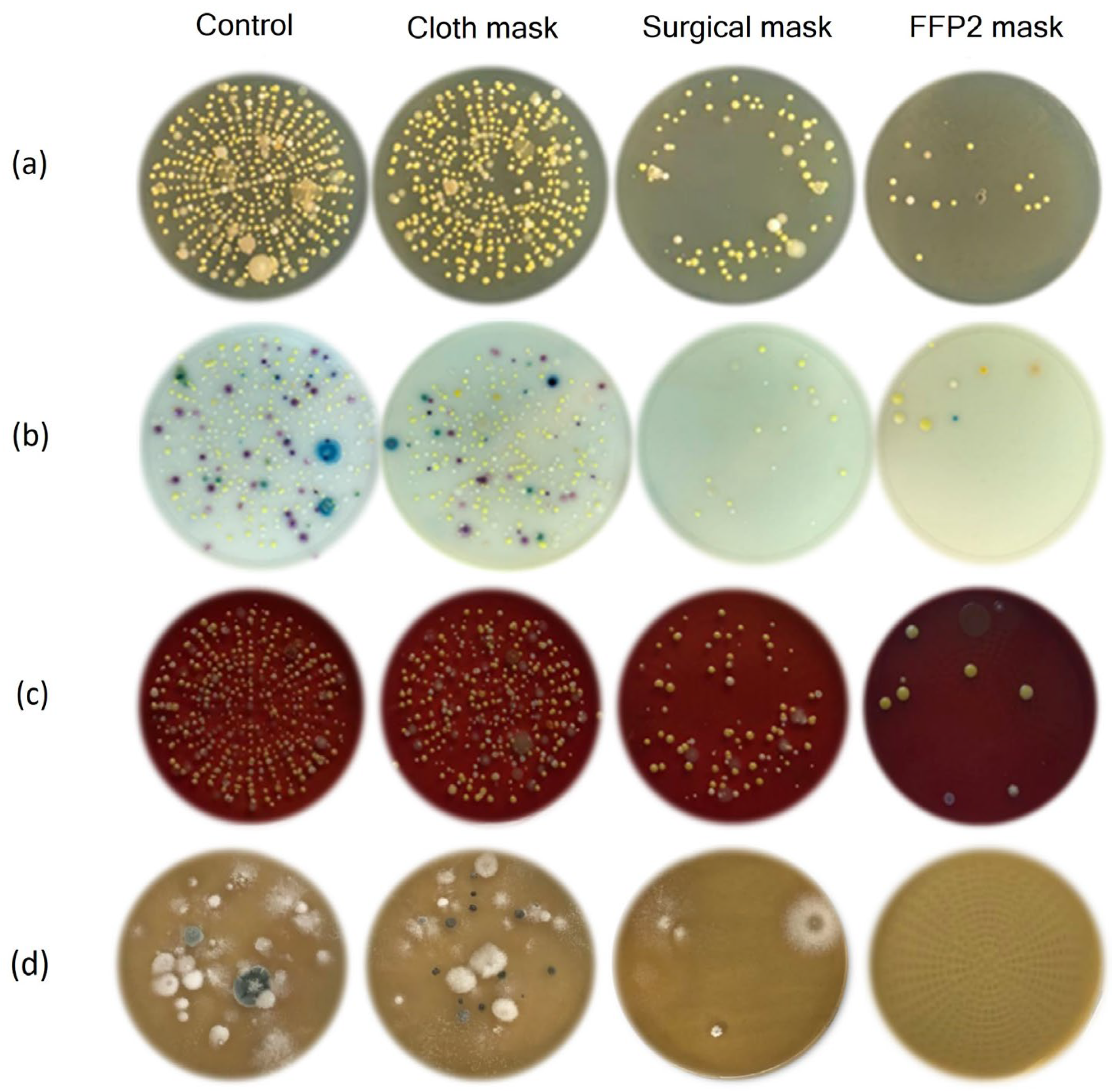

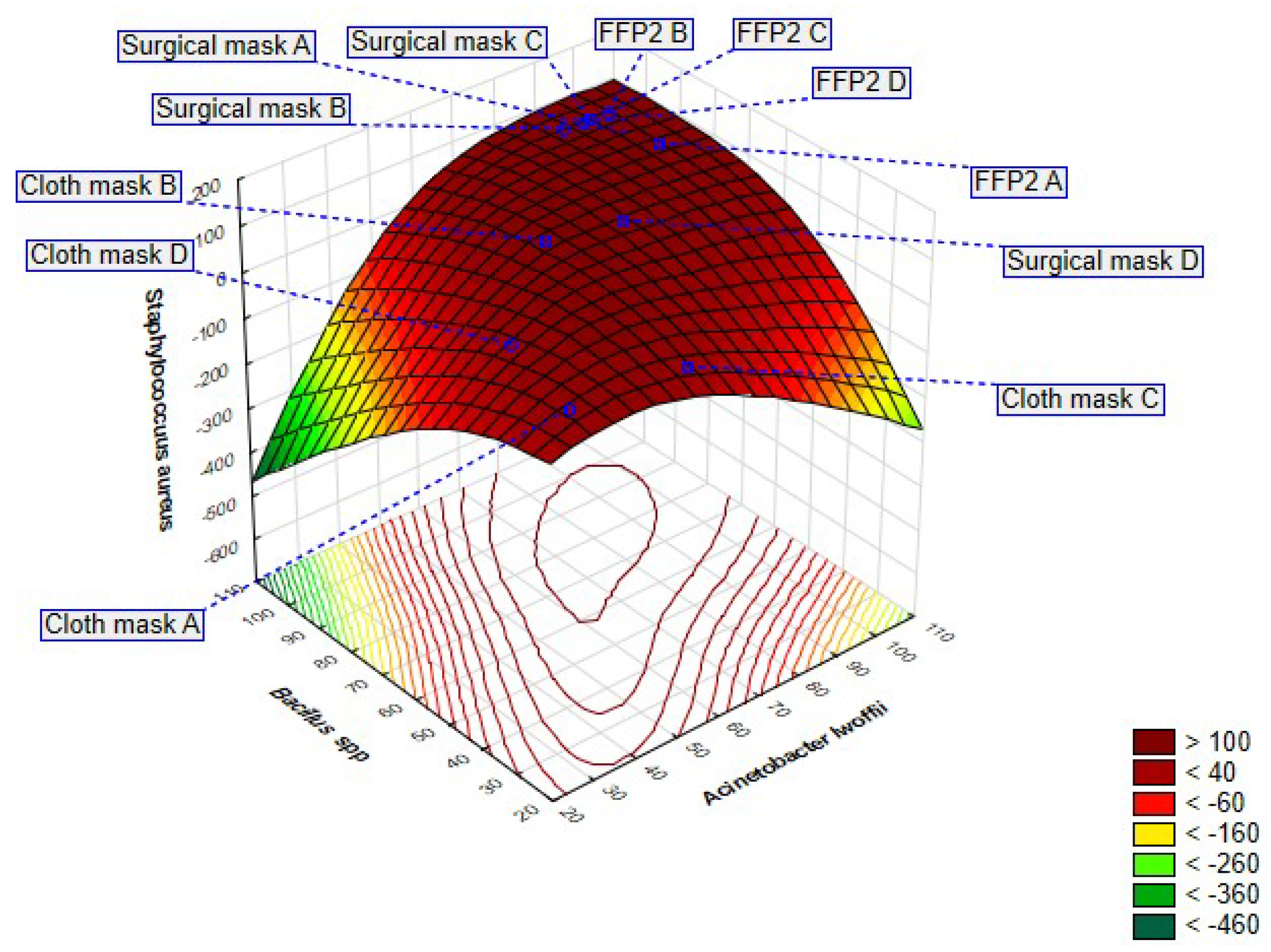
| Humidity (%) | Temperature (°C) | Persons per Room | Room Area (m2) | |
|---|---|---|---|---|
| Location A (kindergarten group A) | 34 | 21.0 | 21 | 60 |
| Location B (kindergarten group B) | 33 | 21.5 | 10 | 60 |
| Location C (primary school group C) | 35 | 23.3 | 23 | 55 |
| Location D (primary school group D) | 38 | 22.1 | 18 | 49 |
| Bacteria/ Treatment | Location A | Location B | ||||||
|---|---|---|---|---|---|---|---|---|
| Control | Cloth Mask | Surgical Mask | FFP2 Mask | Control | Cloth Mask | Surgical Mask | FFP2 Mask | |
| Acinetobacter lwoffii | 61.33 (±2.52) | 42.33 A (±3.06) | 1.67 A,a (±0.58) | 0.00 A,a,b (±0.00) | 21.67 (±1.53) | 8.67 A (±0.58) | 2.33 A,a (±0.58) | 0.00 A,a,b (±0.00) |
| Bacillus spp. | 15.33 (±1.15) | 11.00 A (±1.00) | 1.33 A,a (±0.58) | 2.33 A,a (±0.58) | 6.67 (±0.58) | 2.00 A (±0.00) | 0.00 A,a (±0.00) | 0.00 A,a (±0.00) |
| Corynebacterium spp. | - | - | - | - | - | - | - | - |
| Micrococcus luteus | 136.67 (±6.11) | 128.67 (±5.03) | 12.00 A,a (±1.00) | 5.33 A,a,b (±1.53) | 467.00 (±9.00) | 142.33 A (±16.26) | 19.67 A,a (±1.15) | 0.00 A,a,b (±0.00) |
| Micrococcus spp. | 7.33 (±0.58) | 0.00 A (±0.00) | 0.00 A (±0.00) | 0.00 A (±0.00) | 1.00 (±0.00) | 0.00 (±0.00) | 0.00 (±0.00) | 0.00 (±0.00) |
| Staphylococcus aureus | 37.67 (±3.06) | 15.67 A (±0.58) | 0.00 A,a (±0.00) | 0.00 A,a (±0.00) | 3.67 (±0.58) | 0.00 A (±0.00) | 0.00 A (±0.00) | 0.00 A (±0.00) |
| Staphylococcus chromogenes | 25.33 (±1.53) | 5.33 A (±0.58) | 0.00 A,a (±0.00) | 1.33 A,a,b (±0.58) | 4.67 (±0.58) | 3.33 A (±0.58) | 2.33 A (±0.58) | 0.00 A,a,b (±0.00) |
| Staphylococcus haemolyticus | 56.67 (±5.03) | 52.67 (±1.53) | 5.67 A,a (±0.58) | 1.00 A,a,b (±0.00) | 10.67 (±1.53) | 8.33 (±0.58) | 2.33 A,a (±0.58) | 0.00 A,a,b (±0.00) |
| Staphylococcus lentus | 8.67 (±0.58) | 7.33 (±1.15) | 0.00 A,a (±0.00) | 0.00 A,a (±0.00) | - | - | - | - |
| Staphylococcus epidermidis 1 | - | - | - | - | - | - | - | - |
| Bacteria/ Treatment | Location C | Location D | ||||||
|---|---|---|---|---|---|---|---|---|
| Control | Cloth Mask | Surgical Mask | FFP2 Mask | Control | Cloth Mask | Surgical Mask | FFP2 Mask | |
| Acinetobacter lwoffii | 52.33 (±3.51) | 22.33 A (±1.53) | 2.33 A,a (±0.58) | 0.00 A,a,b (±0.00) | 44.67 (±3.06) | 28.00 A (±2.65) | 11.00 A,a (±1.00) | 2.66 A,a,b (±1.15) |
| Bacillus spp. | 8.67 (±0.58) | 6.33 A (±0.58) | 0.00 A,a (±0.00) | 0.00 A,a (±0.00) | 7.00 (±0.00) | 3.33 A (±0.58) | 2.33 A (±0.58) | 0.00 A,a,b (±0.00) |
| Corynebacterium spp. | 10.33 (±1.53) | 5.00 A (±1.00) | 0.00 A,a (±0.00) | 0.00 A,a (±0.00) | 8.33 (±1.53) | 7.67 (±0.58) | 3.33 A,a (±0.58) | 0.00 A,a,b (±0.00) |
| Micrococcus luteus | 101.67 (±6.51) | 51.00 A (±3.00) | 2.00 A,a (±0.00) | 2.00 A,a (±0.00) | 453.00 (±24.06) | 361.00 A (±21.93) | 104.00 A,a (±16.70) | 6.33 A,a,b (±0.58) |
| Micrococcus spp. | 9.33 (±1.15) | 7.00 (±1.00) | 1.33 A,a (±0.58) | 0.00 A,a,b (±0.00) | 6.33 (±0.58) | 5.33 (±0.58) | 2.00 A,a (±0.00) | 2.00 A,a (±0.00) |
| Staphylococcus aureus | 5.67 (±1.15) | 3.00 A (±1.00) | 0.00 A,a (±0.00) | 0.00 A,a (±0.00) | 4.00 (±1.00) | 2.00 A (±0.00) | 0.00 A,a (±0.00) | 0.00 A,a (±0.00) |
| Staphylococcus chromogenes | - | - | - | - | 3.00 (±1.00) | 1.33 (±0.58) | 0.00 A,a (±0.00) | 0.00 A,a (±0.00) |
| Staphylococcus haemolyticus | 64.00 (±5.00) | 27.00 A (±1.00) | 11.67 A,a (±1.15) | 0.00 A,a,b (±0.00) | 16.33 (±1.53) | 11.33 A (±0.58) | 5.67 A,a (±1.15) | 3.33 A,a (±1.53) |
| Staphylococcus lentus | 1.33 (±0.58) | 0.00 A (±0.00) | 0.00 A (±0.00) | 0.00 A (±0.00) | - | - | - | - |
| Staphylococcus epidermidis 1 | 3.33 (±0.58) | 1.67 A (±0.58) | 0.00 A,a (±0.00) | 0.00 A,a (±0.00) | 1.00 (±0.00) | 0.00 (±0.00) | 0.00 (±0.00) | 0.00 (±0.00) |
| Variable | Eigenvectors Spreadsheet | Variable Contributions | ||||
|---|---|---|---|---|---|---|
| p1 | p2 | p3 | p1 | p2 | p3 | |
| Yeasts | 0.37 | −0.01 | 0.11 | 0.14 | <0.01 | 0.01 |
| Acinetobacter lwoffii | 0.37 | −0.17 | 0.05 | 0.14 | 0.03 | <0.01 |
| Bacillus spp. | 0.36 | −0.01 | −0.24 | 0.13 | <0.01 | 0.06 |
| Corynebacterium spp. | 0.27 | 0.37 | 0.28 | 0.08 | 0.13 | 0.08 |
| Micrococcus luteus | 0.37 | −0.16 | −0.07 | 0.14 | 0.02 | 0.01 |
| Micrococcus spp. | 0.26 | 0.45 | 0.20 | 0.07 | 0.20 | 0.04 |
| Staphylococcus aureus | 0.36 | 0.13 | −0.15 | 0.13 | 0.02 | 0.02 |
| Staphylococcus chromogenes | 0.11 | −0.31 | 0.67 | 0.01 | 0.10 | 0.45 |
| Staphylococcus haemolyticus | 0.33 | −0.31 | 0.14 | 0.11 | 0.09 | 0.02 |
| Staphylococcus lentus | 0.18 | −0.46 | −0.46 | 0.03 | 0.21 | 0.22 |
| Staphylococcus epidermidis 1 | 0.17 | 0.43 | −0.31 | 0.03 | 0.19 | 0.10 |
Disclaimer/Publisher’s Note: The statements, opinions and data contained in all publications are solely those of the individual author(s) and contributor(s) and not of MDPI and/or the editor(s). MDPI and/or the editor(s) disclaim responsibility for any injury to people or property resulting from any ideas, methods, instructions or products referred to in the content. |
© 2023 by the authors. Licensee MDPI, Basel, Switzerland. This article is an open access article distributed under the terms and conditions of the Creative Commons Attribution (CC BY) license (https://creativecommons.org/licenses/by/4.0/).
Share and Cite
Linšak, Ž.; Ražov, L.; Furlan, N.; Begić, G.; Pavičić Žeželj, S.; Crvelin, G.; Broznić, D.; Tomić Linšak, D. Bacteria Filtration Efficiency for Different Types of Protective Face Masks. Appl. Sci. 2023, 13, 5972. https://doi.org/10.3390/app13105972
Linšak Ž, Ražov L, Furlan N, Begić G, Pavičić Žeželj S, Crvelin G, Broznić D, Tomić Linšak D. Bacteria Filtration Efficiency for Different Types of Protective Face Masks. Applied Sciences. 2023; 13(10):5972. https://doi.org/10.3390/app13105972
Chicago/Turabian StyleLinšak, Željko, Lucija Ražov, Nikolina Furlan, Gabrijela Begić, Sandra Pavičić Žeželj, Goran Crvelin, Dalibor Broznić, and Dijana Tomić Linšak. 2023. "Bacteria Filtration Efficiency for Different Types of Protective Face Masks" Applied Sciences 13, no. 10: 5972. https://doi.org/10.3390/app13105972
APA StyleLinšak, Ž., Ražov, L., Furlan, N., Begić, G., Pavičić Žeželj, S., Crvelin, G., Broznić, D., & Tomić Linšak, D. (2023). Bacteria Filtration Efficiency for Different Types of Protective Face Masks. Applied Sciences, 13(10), 5972. https://doi.org/10.3390/app13105972







